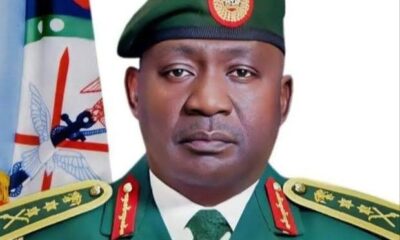Article
Terrorism/CounterInsurgency Economy: Citizens-centric component in peace building

Benneth Joshua Kingsley
Modern militarized conflicts are open cheques that draw inspiration from faucets of ideas.

They’re no longer a one-street shop where operators, be they state actors or otherwise, focus on just one approach to achieving their aims.
By this it is implied that conflicts like terrorism require not only military-combat centric solutions to deal with. They also call for intelligence gathering where citizens play pivotal roles as discreet intelligence agents.
It is worthy of note that throughout history the world has been plagued by insurgencies. Though the underlying causes of each new insurgency have been different, they are all similar in certain areas.
It is also worthy of note that insurgencies are flexible and to defeat them the counterinsurgency must be equally flexible if not more flexible.
This flexibility is where intelligence gathering comes in. Good intelligence is critical to the success of any counterinsurgency.
Come to think of it! With their small, poorly equipped forces, the leaders of insurgencies need to know when to strike and when to pull back.
This reliance on intelligence means that an effective counterinsurgency must also rely on good intelligence so that the counterinsurgents may know where the insurgents will strike, where they are based, how they are supplied, where they keep their weapons, and other essential pieces of information
Intelligence gathering must be accomplished in the most difficult conditions and from inhabitants who do not want to get involved.
Ahead of the discussion on intelligence gathering in counterinsurgency, it is directional to borrow United States Navy Captain, Daniel J. Smith’s concept of insurgency in his work “Intelligence Gathering In A Counterinsurgency”.
Navy Captain Smith in quoting Col. Roger Trinquier, French Army and Father of Modern Counterinsurgency, believes that the phenomenon is “An interlocking system of actions–political, economic, psychological, military that aims at the overthrow of the established authority in a country and its replacement by another regime”.
He went on to elucidate the role of insurgency in modern warfare.
US Navy Captain Smith believes that in modern warfare we are not actually grappling with an army organized along traditional lines, but with a few armed elements acting clandestinely within a population manipulated by a special organization . . . whose essential role is to impose its will upon the population.
He says that victory [against this armed clandestine organization] will be obtained only through the complete destruction of that organization through the elements of intelligence gathering that is at the center of both sides of insurgency warfare.
According to him, insurgency may endure for years or decades until resolved. “Most insurgencies in history have lasted from half a dozen to a score of years”.
Once an insurgency takes root among an indigenous people in a region, the population becomes the key to resolving the conflict – one way or another.
Realizing this, the Philippine Army in 2020, in Agusan del Norte, recruited the help of strong communities among the Indigenous Peoples (IPs) in the province to end the local conflicts caused by the communist insurgency.
Here is the thing- insurgency or guerrilla warfare takes place within delineated zones that give the actors cover as they strike and retreat.
Like in the case of Boko Haram in Nigeria’s northeast region, the insurgents embeded themselves in the local population which sympathy and support provides them with the necessary morale to engage security forces.
The local population also became their intelligence apparatus as they provided the terrorists with timely reconnaissance on troop movement, logistics and other such details decipherable mostly at first instance.
Though the Nigerian military for obvious strategic reasons played down on the extent of the casualties suffered by troops from this strategic guerrilla reconnaissance, it is evident that the state recorded heavy losses.
One was therefore not bemused, at the early stages of the crisis, when news of high handedness of troops against local civilian population began to filter to public space.
It is thus convenient to argue that the only effective way to restore security and effectively combat violent extremism is to put the protection of civilians at the heart of military operations.
If the military protects civilians from insurgents, works to ensure its own operations to combat terrorism do not harm civilians, and creates a secure environment for civilians to Whistleblow, the cycle of violence can be broken.
In the process, the military will also gain the trust and support of affected communities. After all, if communities feel victimized or abandoned to their fate in the hands of terrorists, by security forces, they are likely to obstruct their operations, or even support the rebellion.
In fact, counterinsurgency operations often do more to harm the civilian population than to keep it safe. A trend that must be reversed.
Instead of employing a holistic high-handed tactics, bearing in mind that insurgents become merciless and disastrously brutal on civilian population (e.g ISIL in Syria and Iraq, and Boko Haram in northern Nigeria, etc) as a result of increasingly brutal and repressive actions of the military, the military may adopt the ‘carrot – and – stick’ combat approach where military collaborators are strategically, not openly rewarded.
Open rewards could expose them to hate from neighbours, and other members of the local population sympathetic to the course of the none state actors.
Such collaboration in the area of intelligence gathering would see more effective counterinsurgency than otherwise.
And this is where the citizens-centric component in peace building factors into terrorism and counter-terrorism, and its attendant economic ramifications.
The economic angle to this is that a citizen centric military intervention in an insurgency active environment helps to among others;
Speedily quell insurgency
Apprehend or neutralize insurgency leaders
Restore public peace and economic activities in affected areas
Limit impact of crisis to lives and livelihoods, as well as destruction to properties
Restore National GDP to the path of growth
Restore community and personal economy / income
Restore family incomes
Identify social, political or economic lacuna that led to crisis in the first place
Seemingly, the implementation of peace-building interventions at the terminal stage of conflict, otherwise known as post-conflict peace-building, is becoming increasingly impracticable.
For instance, in Nigeria, military counter operation against Boko Haram takes place in and around civilian populations, against arm-carrying non-state actors.
A community centric, bottom-up approach which emphasizes the security, reconstruction and reintegration needs of civilians and defecting combatants, as support to citizens-oriented military collaboration is essential to peace building efforts.
And it is advised that such peace should, as have earlier been pointed out here, commence by building confidence with the local population.
Also, by prioritizing the inclusive needs of affected communities, the state is likely to win over the population, drawing on the combined expertise and resources of military and civilian actors.
The implementation of such an approach will require in amongst others, a reorientation of the military roles, a renewed relation of mutual assistance between civilian and military actors in affected areas.

























